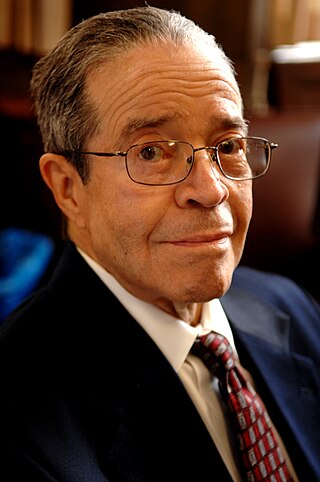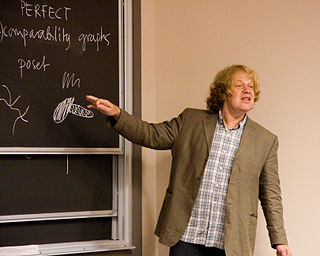Related Research Articles

Fan-Rong King Chung Graham, known professionally as Fan Chung, is an American mathematician who works mainly in the areas of spectral graph theory, extremal graph theory and random graphs, in particular in generalizing the Erdős–Rényi model for graphs with general degree distribution.

Richard Kenneth Guy was a British mathematician. He was a professor in the Department of Mathematics at the University of Calgary. He is known for his work in number theory, geometry, recreational mathematics, combinatorics, and graph theory. He is best known for co-authorship of Winning Ways for your Mathematical Plays and authorship of Unsolved Problems in Number Theory. He published more than 300 scholarly articles. Guy proposed the partially tongue-in-cheek "strong law of small numbers", which says there are not enough small integers available for the many tasks assigned to them – thus explaining many coincidences and patterns found among numerous cultures. For this paper he received the MAA Lester R. Ford Award.
Peter Benjamin Borwein was a Canadian mathematician and a professor at Simon Fraser University. He is known as a co-author of the paper which presented the Bailey–Borwein–Plouffe algorithm for computing π.

Robin James Wilson is an English mathematician. He is a emeritus professor in the Department of Mathematics at the Open University, having previously been Head of the Pure Mathematics Department and Dean of the Faculty. He was a stipendiary lecturer at Pembroke College, Oxford and, as of 2006, Gresham Professor of Geometry at Gresham College, London, where he has also been a visiting professor. On occasion, he teaches at Colorado College in the United States. He is also a long standing fellow of Keble College, Oxford.

Jesse Ernest Wilkins Jr. was an American nuclear scientist, mechanical engineer and mathematician. A child prodigy, he attended the University of Chicago at the age of 13, becoming its youngest ever student. His graduation at a young age resulted in him being hailed as "the Negro Genius" in the national media.
In mathematics and social science, a collaboration graph is a graph modeling some social network where the vertices represent participants of that network and where two distinct participants are joined by an edge whenever there is a collaborative relationship between them of a particular kind. Collaboration graphs are used to measure the closeness of collaborative relationships between the participants of the network.

János Pach is a mathematician and computer scientist working in the fields of combinatorics and discrete and computational geometry.
András Hajnal was a professor of mathematics at Rutgers University and a member of the Hungarian Academy of Sciences known for his work in set theory and combinatorics.
Combinatorial physics or physical combinatorics is the area of interaction between physics and combinatorics.
János Komlós is a Hungarian-American mathematician, working in probability theory and discrete mathematics. He has been a professor of mathematics at Rutgers University since 1988. He graduated from the Eötvös Loránd University, then became a fellow at the Mathematical Institute of the Hungarian Academy of Sciences. Between 1984–1988 he worked at the University of California, San Diego.
Dudley Weldon Woodard was a Galveston-born American mathematician and professor, and the second African-American to earn a PhD in mathematics; the first was Woodard's mentor Elbert Frank Cox, who earned a PhD from Cornell in 1925).
Edward R. Scheinerman is an American mathematician, working in graph theory and order theory. He is a professor of applied mathematics, statistics, and computer science at Johns Hopkins University. His contributions to mathematics include Scheinerman's conjecture, now proven, stating that every planar graph may be represented as an intersection graph of line segments.
Edray Herber Goins is an American mathematician. He specializes in number theory and algebraic geometry. His interests include Selmer groups for elliptic curves using class groups of number fields, Belyi maps and Dessin d'enfants.
Martin Grohe is a German mathematician and computer scientist known for his research on parameterized complexity, mathematical logic, finite model theory, the logic of graphs, database theory, and descriptive complexity theory. He is a University Professor of Computer Science at RWTH Aachen University, where he holds the Chair for Logic and Theory of Discrete Systems.

Wade Ellis was an American mathematician and educator. He taught at Fort Valley State University in Georgia and Fisk University in Nashville, Tennessee and earned his Ph.D. in mathematics from the University of Michigan in 1944. He carried out classified research on radar antennas at the MIT Lincoln Laboratory and taught at Boston University and Oberlin College, where he became Full Professor in 1953. The same year, he was elected to the Board of Governors of the Mathematical Association of America.
Bonita Valerie Saunders is an American mathematician specializing in mathematical visualization. She works at the National Institute of Standards and Technology in the Applied and Computational Mathematics Division of the Information Technology Laboratory, where she contributes to the Digital Library of Mathematical Functions as the Visualization Editor and the principal designer of visualizations and graphs.
Walter Richard Talbot (1909-1977) was the fourth African American to earn a Ph.D. in Mathematics from the University of Pittsburgh and Lincoln University's youngest Doctor of Philosophy. He was a member of Sigma Xi and Pi Tau Phi. In 1969 Talbot co-founded the National Association of Mathematics (NAM) at Morgan State University, the organization which, nine years later honored him at a memorial luncheon and created a scholarship in his name. In 1990 the Cox-Talbot lecture was inaugurated recognizing his accomplishments together with Elbert Frank Cox – the first African-American to get a doctoral degree in mathematics.
Virginia Kimbrough Newell is an American mathematics educator, author, politician, and centenarian.
Abdul–Aziz Yakubu was a mathematical biologist. Yakubu was a professor at Howard University for over 20 years and served as chair of the mathematics department from 2004 to 2014.
References
- ↑ "Nathaniel Dean". Mathematically Gifted & Black. Retrieved 2022-04-07.
- 1 2 3 "Nathaniel Dean - The Mathematics Genealogy Project". Mathematics Genealogy Project. North Dakota State University. n.d. Retrieved June 10, 2020.
- 1 2 3 Williams, Scott (2008). "Nathaniel Dean - Mathematicians of the African Diaspora". Mathematicians of the African Diaspora. The Mathematics Department of The State University of New York at Buffalo. Retrieved June 10, 2020.
Until 1998, Dr. Dean was a member of the Software Production Research Department of Bell Laboratories.
- 1 2 "Nathaniel Dean - Google Scholar Citations". Google Scholar. Google, Inc. n.d. Retrieved June 10, 2020.
- ↑ Dean, Nathaniel; Latka, Brenda J. (1995), "Squaring the tournament—an open problem", Proceedings of the Twenty-Sixth Southeastern International Conference on Combinatorics, Graph Theory and Computing (Boca Raton, FL, 1995), Congressus Numerantium, 109: 73–80, MR 1369296
- ↑ Fisher, David C. (1996), "Squaring a tournament: a proof of Dean's conjecture", Journal of Graph Theory , 23 (1): 43–48, doi:10.1002/(SICI)1097-0118(199609)23:1<43::AID-JGT4>3.0.CO;2-K, MR 1402137
- ↑ WQED Pittsburgh (1998). "Life by the Numbers - Information Age - A New Age". Life by the Numbers. Season 1. Episode 6. 57 minutes in. The Public Broadcasting Service. YouTube video.
- ↑ "Personal Profile of Dr. Nathaniel Dean". Mathematical Sciences Research Institute. n.d. Retrieved June 10, 2020.
In 1997 he received the President's Silver Award from Bell Laboratories.
- ↑ Williams, Dr. Scott (Spring 2001). "Volume 32, Issue 1". N.A.M. Newsletter. The State University of New York, Buffalo: National Association of Mathematicians. Retrieved June 10, 2020.
- ↑ Williams, Dr. Scott (Spring 2003). "Volume 34, Issue 1". N.A.M. Newsletter. The State University of New York, Buffalo: National Association of Mathematicians. Retrieved June 10, 2020.
- ↑ Williams, Dr. Scott (Fall 2006). "Volume 37, Issue 1". N.A.M. Newsletter. The State University of New York, Buffalo: National Association of Mathematicians. Retrieved June 10, 2020.
- ↑ Williams, Dr. Scott (Fall 2005). "Volume 36, Issue 3". N.A.M. Newsletter. The State University of New York, Buffalo: National Association of Mathematicians. Retrieved June 10, 2020.
- ↑ Washington, Dr. Talitha (Spring 2015). "Volume 46, Issue 1". N.A.M. Newsletter. Howard University: National Association of Mathematicians. Retrieved June 10, 2020.
- ↑ Buja, Andreas; Swayne, Deborah F; Littman, Michael L; Dean, Nathaniel; Hofmann, Heike; Chen, Lisha (2008). "Data Visualization With Multidimensional Scaling". Journal of Computational and Graphical Statistics. 17 (2): 444–472. doi:10.1198/106186008X318440. ISSN 1061-8600. S2CID 10675294.
- ↑ "Past Faculty : Mathematics : Texas State University". Mathematics : Texas State University. Department of Mathematics at Texas State University. n.d. Retrieved June 10, 2020.
Retired Faculty. ... Nathaniel Dean: Ph.D., Vanderbilt University (1987), 2006 - 2016.
- ↑ Rosenstein, Joseph; Franzblau, Deborah; Roberts, Fred (1997). Discrete Mathematics in the Schools. Discrete Mathematics and Theoretical Computer Science. Vol. 36 (1 ed.). New Jersey: DIMACS. pp. Section 7. ISBN 978-0-8218-0448-3.
- ↑ Dean, Nathaniel (1997). African Americans in mathematics : DIMACS workshop, June 26-28, 1996. Providence, R.I: American Mathematical Society. ISBN 978-0-8218-0678-4. OCLC 36969771.
- ↑ Dean, Nathaniel (1999). African-Americans in mathematics II : fourth Conference for African-American Researchers in the Mathematical Sciences, June 16-19, 1998, Rice University, Houston, Texas. Providence, R.I: American Mathematical Society. ISBN 978-0-8218-1195-5. OCLC 42683053.
- ↑ https://www.ams.org/about-us/governance/committees/notices-past.html